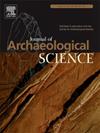Spatial analysis of Amazonian Dark Earth formation supports an anthropic origin at the Caldeirão site, Brazil
IF 2.6
1区 地球科学
Q1 ANTHROPOLOGY
引用次数: 0
Abstract
Amazonian Dark Earths (ADEs) are distinct archaeological sites in the Amazon, characterized by their enriched nutrient content in soil layers. While activities related to human occupation are acknowledged as the primary driver of the geochemical properties of ADEs, the intra-site spatial variations in their formation processes, and how they relate to human settlement, are not completely documented. In this study, we employ geostatistical analysis to investigate spatial variations in the geochemical signature and pottery concentration of ADE at the Caldeirão site, Central Amazon, a site that has sparked ongoing debates due to the revival of a natural genesis hypothesis of ADEs. Our findings reveal non-homogeneous spatial distribution of the ADE geochemical signature at the site, suggesting multiple foci of human activity at different temporal stages. Notably, we document the possible emergence of a semi-circular village pattern, prevalent in other Amazonian contexts, gradually transitioning to a more homogeneous ADE cover during the final stage of occupation. This observed pattern, consistent with archaeological and ethnographic evidence, provides compelling evidence for human activity as the primary driver of ADE formation at Caldeirão, laying to rest the hypothesis of a natural origin.
亚马逊暗地球形成的空间分析支持巴西caldeir遗址的人为起源
亚马逊暗地球(ADEs)是亚马逊地区独特的考古遗址,其特征是土壤中富含营养成分。虽然与人类活动有关的活动被认为是ADEs地球化学性质的主要驱动因素,但其形成过程中的遗址内空间变化及其与人类住区的关系尚未得到完整的记录。在这项研究中,我们利用地质统计学分析研究了亚马逊中部caldeir遗址的ADE地球化学特征和陶器浓度的空间变化,该遗址由于ADE自然成因假说的复兴而引发了持续的争论。研究结果显示,该遗址的ADE地球化学特征空间分布不均匀,表明人类活动在不同的时间阶段存在多个焦点。值得注意的是,我们记录了在其他亚马逊环境中普遍存在的半圆形村庄模式的可能出现,并在占领的最后阶段逐渐过渡到更均匀的ADE覆盖。这一观察到的模式与考古和人种学证据相一致,为人类活动是caldeir ADE形成的主要驱动力提供了令人信服的证据,为自然起源的假设奠定了基础。
本文章由计算机程序翻译,如有差异,请以英文原文为准。
求助全文
约1分钟内获得全文
求助全文
来源期刊

Journal of Archaeological Science
地学-地球科学综合
CiteScore
6.10
自引率
7.10%
发文量
112
审稿时长
49 days
期刊介绍:
The Journal of Archaeological Science is aimed at archaeologists and scientists with particular interests in advancing the development and application of scientific techniques and methodologies to all areas of archaeology. This established monthly journal publishes focus articles, original research papers and major review articles, of wide archaeological significance. The journal provides an international forum for archaeologists and scientists from widely different scientific backgrounds who share a common interest in developing and applying scientific methods to inform major debates through improving the quality and reliability of scientific information derived from archaeological research.
 求助内容:
求助内容: 应助结果提醒方式:
应助结果提醒方式:


